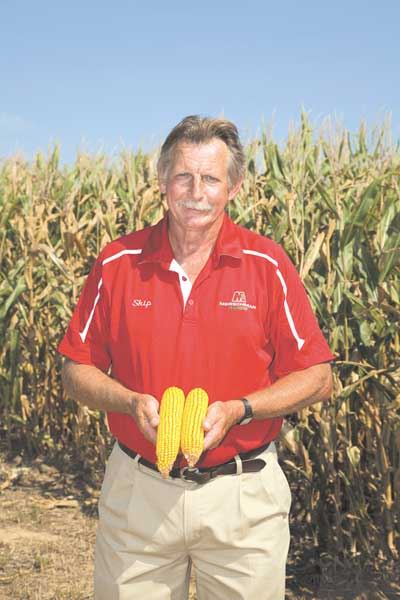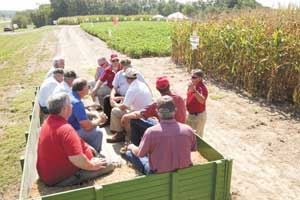|
Growers See Yields Soar In Trial Plots At Buchheits
BETTY VALLE GEGG-NAEGER
MidAmerica Farmer Grower
BIEHLE, MO.
Two years ago, Merschman Seeds began growing trial plots of corn in Biehle, Mo. for Buchheit Agri, in an effort to test different varieties in southeast Missouri conditions, soil types, etc. Recently, Arthur L. “Skip” Long, also known as “Mr. Corn,” product manager for Merschman Seeds, was present for a field day to showcase the trial results.
“As you get to the plot you’ll see this isn’t just an ordinary plot,” he said. “We have a lot of corn and bean options for the growers today. We’re out of Iowa but what works in Iowa doesn’t necessarily work for you here. This gives us the option of putting our seeds in a real world scenario for you so you get the chance to see what it actually does here under your conditions, your soil types. So that’s part of the reason we started working with Buchheit Agri.”
Buchheit purchased the ground and Merschman reps came in and planted it for them.
“We had no idea what we were getting into,” Long said. “Last year the ground was hard and fertility was low. We’ve been able to correct that this year, but the idea is to give farmers in southeast Missouri, southern Illinois, the option of looking at corn hybrids and soybeans under their local conditions, and soil variabilities.”
Long is a product manager but his forte is corn. He is in charge of selecting all the corn hybrids for the company. He likes visiting at field days and working with the growers.

Long stated that people can come and go as they
like all day at the field day. “There’s food, visiting,
and the opportunity for him to discuss problem
scenarios with farmers.
Photos by John LaRose, Jr.

“Their comments are important,” he said. “You have to listen. What do they want? Most farmers will tell you they want a consistent average yield year in and year out. They want to know what it takes to get 300 bushel corn, and what risks you have getting there. Is it cost effective?”
Long works with corn and likes to quote Joe Merschman, the President and CEO of Merschman Seeds, who says they’re kind of like Skip’s children. “They are,” he said. “I look after them, I take care of them and I’m just like any parent who knows you have to discipline them and sometimes you have to see if you can challenge them to make them stronger. That’s my job with Merschman Seeds. I’m also familiar with soybeans and wheat. I have to be, and we also offer alfalfa. That gives farmers other options, but our main focus is corn, wheat and soybeans.”
Merschman carries two different soybean traits, Roundup Ready 2 Yield® and LibertyLink®. The company also has a vested interest in Mertec, LLC and M.S. Technologies® LLC which are working on bringing new soybeans traits and genetics to farming. The company also works closely with Dave Danker and Tim Buchheit, of Buchheit Agri and their hopes are the test plot will be as productive as last year.
“Thanks to Buchheit Agri we are able to do this, people can come and go as they like all day at the field day,” he said. “There’s food, visiting, and the opportunity to discuss problem scenarios. With wheat season approaching, farmers can view some excellent early wheat lines for double cropping. So this field day gives farmers lots of options.”
Showing last year’s results, Long said that when the crop was planted in late May, Dave Danker commented that “if we get 100 bushel corn per acre, we’ll be happy.”
“Fertility was not great on this ground when we started so we double applied urea, and we doubled up on phosphate and potassium to improve the fertility base. I think it shocked a lot of the farmers who came through last year to realize we got 220 bushel corn off that; but it also goes to show what can happen when planting 30,000 to 40,000 seeds per acre. You need to push populations of corn. An additional 1,000 plants can easily bring you an additional eight to 10 bushel of corn, so why wouldn’t you?”
These corn varieties today will not leave barren stalks. They produce an ear. At the research facility at Iowa City last year, the plots had 4.5 to 5 inches of rain for the entire year. That’s not a lot, and there still was a yield.
“One of the guys there asked how that’s possible. I explained with 37,000 population, every stalk had an ear and every ear had kernels,” Long said. “So we’re going to have to push corn populations.
“For soybeans with our seed treatment, we recommend cutting soybean populations. Soybeans are not the same, if you have 100,000 final stand that is uniform, you have plenty of beans. If you think you’re planting too many beans, go out in your bean field, and if you see barren plants that tells me your population may be too high. That’s just another observation, just go out and tweak things and see what is happening.
“Last year we didn’t harvest the soybeans for yield because they were mainly show plots. Then wheat was planted and after the wheat we double-cropped soybeans. Today they are waist high. I’m really amazed. Sudden Death is showing up in beans in Iowa. I haven’t seen that much here though I’ve heard there are some issues.”
Much of that has to do with planting early and high fertility or any kind of stress such as compaction. Sudden Death is a big issue in Iowa; it always has been.
Long couldn’t say whether the crop is on the same track this year.
“I would question whether we are or not. We had some wind events, there was some green snap and some lodging and north of here they took hail and lost everything. Even on our research farm we took some wind. Weather has been so erratic and very spotty, but I still wouldn’t be surprised if there’s not a 200 bushel yield here. I would be real surprised and I think the beans will be stronger than last year.
“We’re always looking for new options to give the farmer, and Merschman Seeds has been a leader and an innovator in seed treatments from day one,” Long added. “We think we have the best seed treatment you can put on your corn. We’re also tweaking the soybean treatments so they will be just right for soybeans. We have some potential new options for soybeans, especially if you have Sudden Death or nematode problems, we can treat accordingly. We’re also putting a premier seed treatment on wheat. Our promise to farmers is ‘Best Seed, Best Treatments, Best Service, Expect the Best’.”
“One of the reasons we do improved seed treatments on corn is Pythium, a major issue for farmers,” Long said. “We really think our seed treatment is going to help and we’ve actually isolated a hybrid or two that has excellent tolerance to Pythium. So we’ve got two options for Pythium problems for farmers. This year we saw very little of this disease that hurts stands. The last 4 or 5 years we’ve had some farmers who replanted because of cool temperatures and Pythium. Local farmers here definitely had cool temperatures last spring. In some respects, what I’m seeing on corn is due to the cool temperatures and planting early; it pinched one if not two sets of kernels around the cob and I’m talking sets; rows come in pairs, so in some cases you lost two rows and in some cases you lost four.”
Merschman Seeds is offering a new hybrid guarantee for 2015. You will get the corn hybrid that you ordered or we will give you the replacement seed free. The offer is detailed on our web page, or can be confirmed by a Merschman dealer or rep. Requirements are that it be ordered by Jan. 15, 2015, and the order confirmed by Merschman Seeds. This doesn’t include grade or weight, but the hybrid that is ordered. If the corn hybrid ordered cannot be provided, the substitution seed is free.
“This will challenge some of the big seed companies to match, because some do a lot of substitutions,” he said. “We don’t feel that that’s right, because farmers should get what they order. Farmers shouldn’t accept substitutions.”
The company is planning a weed resistance meeting in the Bootheel this fall again. The meeting will be Wednesday Nov. 12, 2014, at Isle Casino, Cape Girardeau, Mo., beginning at 6 pm. One was held last year and there were almost 300 people attending. Any time knowledge is presented to farmers there will be a crowd because farmers today are eager to learn.
Long has been in southern Missouri, across Iowa, Illinois, Nebraska, covering a wide area in the last month.
“There are isolated pockets where the crop is not going to be excellent by any means, but for the most part we’ve probably got the biggest crop on record on the way,” he said. ∆
BETTY VALLE GEGG-NAEGER: Senior Staff Writer, MidAmerica Farmer Grower
|
|